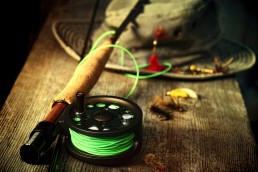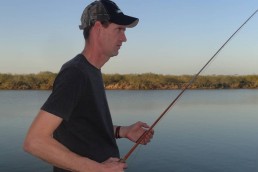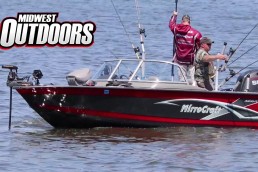Understanding Fly Fishing and its Vocabulary
SHARE THIS POST
“Match the hatch,” dry fly, wet fly, a 2-weight rod, terrestrial, nymph, double tapper—each type of fishing and tool has its own unique vernacular. Fly fishing has more than most. I believe it was started as a way to confuse hook-and-line fishers so we wouldn’t dilute the fly fishing elite.
Well, no more.
With only a small investment and an hour of practice, you can fly fish. You may not look like Brad Pitt in A River Runs Through It, but you will be catching fish just as well. And like equipment used in other forms of fishing, this sport’s tools have also evolved into many different rods, reels and line for specific applications. With one basic rod and a couple of reels with different lines, you can catch anything from bluegills to trout to northerns.
There’s nothing mystical about fly fishing; it’s just a different way of delivering a lure to a fish. In spinning or casting, it’s the weight of the lure itself that propels it to its destination and that has some inherent limitations as to the size of lure you cast. It’s impossible to cast a “feather,” but with fly fishing, it’s the line that provides the momentum to deliver a lure, giving you an ability to cast one with the right fly that weighs literally nothing.
Fly rods
Fly rods and line are categorized by “weight.” Weight is a system of matching a certain size of line with the correct rod. Lines range in size from 1 to 15. You can go up or down one weight of line for a specific weighted rod. If there’s a mismatch, either you won’t cast effectively or will break a rod tip. Although there’s somewhat of a relationship between weight and strength of line, the primary reason for having different weights available is so you can cast different-sized flies. The 1- and 2-weight lines/rods are designed to cast tiny 18- to 22-sized flies with a great deal of finesse, whereas 10, 11 and up are designed to heave “humongous-sized” saltwater tarpon flies.
The length of the rod affects casting distance too. In general, the longer the rod the farther you can cast, but you will be limited in your finesse. And remember, accuracy is usually more important than distance.
A good starting system is right in the middle with a 5- to 6-weight rod in 7 to 8 feet in length. This system will allow you to throw flies from number 12s (bluegills, crappies) to 4s (for bass). This setup is not too whippy or so stiff so that it’s harder to cast. And, this will let you use line from 4 that’s subtler, to a 7-weight for larger flies.
Reels
Fly reels aren’t really part of the casting process since you strip off the line before a cast, but they do provide drag. For smaller fish you can hold the line between your fingers and the rod, but a good drag is necessary for larger fish. The least expensive reels have “click drags,” which have a small piece of metal that catches on the spool. As the metal spring catches on this spool it clicks, hence the name. This type of drag is effective for smaller fish, but can be noisy. A better system is a disk or friction drag, as this type has a pad or more of material that presses against the spool with an adjustable amount of pressure. A disk drag is better for bigger fish and can even be adjusted for all sizes and species. No matter what reel you purchase it helps to have a couple spare spools so that you can easily change your line style without changing reels. My White River Intruder works just as well as some of the more expensive reels. Also, forget about the auto-wind reels, as some may only give you grief.
The fly line
There are three basic line styles: level (L), double taper (DT) and weight-forward (WF). Level is the most basic and has the advantage because you can use the entire line. As the tip section gets worn, just cut off a couple feet and go again. The double taper has—as the name suggests—a taper in the last 10 to 15 feet of line that helps the leader turn over easier for better casting. When you have cut most of the taper away from use you can then reverse the line so that the other tapered end can be used, thus extending the life of the line.
Are you enjoying this post?
You can be among the first to get the latest info on where to go, what to use and how to use it!
The weight-forward line has a heavier section in the last 15 to 30 feet to help you make longer casts. It’s also easier cast into the wind, but once you have cut back to a certain point, you must replace the line.
Within each style of line you have floating, sinking, sinking tip. Since most of your fishing will be with floating line, a good starting point is one spool with weight-forward line for bigger flies and farther casts, and a second spool with double taper line for when more finesse in the presentation is required.
Most fly lines are sold in 90 feet of length and will not fill the spool, so a backing line is needed. For larger fish that can make longer runs, a good braided 20-pound-test Dacron line is necessary. I use older fly line as the backer since I have as of yet had a bluegill make a 100-yard run on me. Make sure you label the spool with the size/type of line because it can be difficult to distinguish between all the different weighted lines.
Leaders, tippets
The leader and tippet is what really determines how and where the fly will land; it’s probably the most critical but least thought about part of a fly-fishing system. It’s a tapered piece of monofilament that helps the fly turn over on the back and forward-casts so that it doesn’t get tangled with the main line. It then lands like a feather, and not a stone. Fly fishing addicts make their only leaders from successively narrower pieces of line. Save yourself time and frustration and buying ready-made leaders. The thicker butt section attaches to the fly line and makes for a continuous transfer of power. A tippet, a short piece of mono or fluorocarbon line, is used to connect the leader and the fly. Leaders are sold in 7 to 9 feet, with lengths based on their tapper. Tippet sizes range from 0.015 inches in diameter at 25 pounds in size 03X, and down to 0.003 inches and 1 3/4 pounds in size 8X. Yes, the bigger the number, the smaller the diameter.
All that being said, 4X (6 pounds) to 6X (3 1/2 pounds) of leader will suffice in 90 percent of “common” fishing situations. I use a straight section of mono or fluorocarbon line as leader and tippet. Another trick that saves me time and frustration is using a leader loop rather than mastering the various line-to-leader knots.
Flies and fishing
Forget the specifics—fly casting, or any other caster for that matter, isn’t necessarily learned out of a how-to book. If you want to get hooked on fly fishing, watch a video to get the gist of casting, practice for half an hour or so, and then get in your boat and go fishing for those panfish and bass. You’ll develop better form and different casts as you fish, but really, any form that gets your fly where you want it on a high-percentage basis is ideal.
Invest in specific flies as you grow your skill set, but in the beginning you’ll need two basic flies: a floating “ant” imitation and the sinking Wooly Bugger. These are also the simplest to tie. Get a variety of colors in hook sizes too, from 8 to 12. Even with the boxes of flies that I have accumulated, I still use these two types for most panfish and bass fishing.
As with other types of fishing gear, usually, the more you pay for the better the equipment is, so go with the best you can afford. However, White River Fly Shop and Pflueger both have complete outfits for under $75 and are quality. And don’t be afraid of the needed gear and tackle for fly fishing. The equipment is simple and the basic techniques can be learned in an hour.
What was once a sport for only the rich has been brought within the reach for the masses with Space-Age materials and mass-production techniques. So don’t be left in front of your TV watching actors in rivers using exotic poles and fly fishing in far-off places for fish. It’s likely some of the best fly fishing is right around the corner on or in your nearest lake or stream.
MWO
SHARE THIS POST
Did you enjoy this post?
You can be among the first to get the latest info on where to go, what to use and how to use it!
Doug Thalacker
Doug Thalacker has a Masters of Environment Science from UW-SP and taught high school environmental science and earth science. He has outdoor/wilderness training through Outward Bound and American Red Cross. He has a lifetime of enjoying any activity that involves fields, woods or waters.



